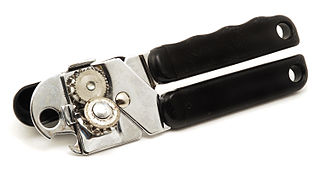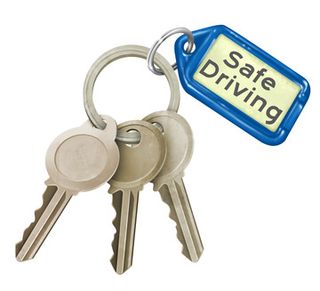
A church key or churchkey is a North American term for various kinds of bottle openers and can openers.

A church key or churchkey is a North American term for various kinds of bottle openers and can openers.


The term in the beverage-opening sense is apparently not an old one; Merriam-Webster finds written attestation only since the 1950s. [1] Several etymological themes exist. The main one is that the ends of some bottle openers resemble the heads of large keys such as have traditionally been used to lock and unlock church doors. [2]

A church key initially referred to a simple hand-operated device for prying the cap (called a "crown cork") off a glass bottle; this kind of closure was invented in 1892, although there is no evidence that the opener was called a church key at that time. [3] The shape and design of some of these openers did resemble a large simple key. [4]
In 1935, beer cans with flat tops were marketed, and a device to puncture the lids was needed. The same term, church key, came to be used for this new invention: made from a single piece of pressed metal, with a pointed end used for piercing cans—devised by D. F. Sampson [5] [6] for the American Can Company, which depicted operating instructions on the cans, [7] and typically gave away free "quick and easy" openers with their beer cans. [8]

Draught beer, also spelt draft, is beer served from a cask or keg rather than from a bottle or can. Draught beer served from a pressurised keg is also known as keg beer.

A circular definition is a description that uses the term(s) being defined as part of the description or assumes that the term(s) being described are already known. There are several kinds of circular definition, and several ways of characterising the term: pragmatic, lexicographic and linguistic.
This is a list of British words not widely used in the United States. In Ireland, Canada, New Zealand, India, South Africa, and Australia, some of the British terms listed are used, although another usage is often preferred.

A drink can is a metal container designed to hold a fixed portion of liquid such as carbonated soft drinks, alcoholic drinks, fruit juices, teas, herbal teas, energy drinks, etc. Drink cans are made of aluminum or tin-plated steel. Worldwide production for all drink cans is approximately 370 billion cans per year.

A can opener or tin opener is a mechanical device used to open tin cans. Although preservation of food using tin cans had been practiced since at least 1772 in the Netherlands, the first can openers were not patented until 1855 in England and 1858 in the United States. These early openers were basically variations of a knife, though the 1855 design continues to be produced. The first can opener, consisting of the now familiar sharp rotating cutting wheel that runs round the can's rim to cut open the lid, was invented in 1870, but was considered very difficult to operate for the ordinary consumer. A successful design came out in 1925 when a second, serrated wheel was added to hold the cutting wheel on the rim of the can. This easy-to-use design has become one of the most popular can opener models.

The P-38 is a small can opener that was issued with canned United States military rations from its introduction in 1942 to the end of canned ration issuance in the 1980s. Originally designed for and distributed in the K-ration, it was later included in the C-ration. As of 2020, it is still in production and sold worldwide.

A keychain is a small ring or chain of metal to which several keys can be attached. The length of a keychain allows an item to be used more easily than if connected directly to a keyring. Some keychains allow one or both ends to rotate, keeping the keychain from becoming twisted, while the item is being used.

A corkscrew is a tool for drawing corks from wine bottles and other household bottles that may be sealed with corks. In its traditional form, a corkscrew simply consists of a pointed metallic helix attached to a handle, which the user screws into the cork and pulls to extract it. Corkscrews are necessary because corks themselves, being small and smooth, are difficult to grip and remove, particularly when inserted fully into an inflexible glass bottle. More recent styles of corkscrew incorporate various systems of levers that further increase the amount of force that can be applied outwards upon the cork, making the extraction of difficult corks easier.

A bottle opener is a device that enables the removal of metal bottle caps from glass bottles. More generally, it might be thought to include corkscrews used to remove cork or plastic stoppers from wine bottles.

A keg is a small barrel.

Ophthalmoscopy, also called funduscopy, is a test that allows a health professional to see inside the fundus of the eye and other structures using an ophthalmoscope. It is done as part of an eye examination and may be done as part of a routine physical examination. It is crucial in determining the health of the retina, optic disc, and vitreous humor.

A flagon is a large leather, metal, glass, plastic or ceramic vessel, used for drink, whether this be water, ale, or another liquid. A flagon is typically of about 2 imperial pints (1.1 l) in volume, and it has either a handle, or one or two rings at the neck. Sometimes the neck has a large flange at the top rather than rings. The neck itself may or may not be formed into one, two or three spouts. The name comes from the same origin as the word "flask".
Wine accessories are things that may be used in the storage or serving of wine. Wine accessories include many items such as wine glasses, corkscrews, and wine racks.

A vial is a small glass or plastic vessel or bottle, often used to store medication in the form of liquids, powders, or capsules. They can also be used as scientific sample vessels; for instance, in autosampler devices in analytical chromatography. Vial-like glass containers date back to classical antiquity; modern vials are often made of plastics such as polypropylene. There are different types of vials such as a single dose vial and multi-dose vials often used for medications. The single dose vial is only used once whereas a multi-dose vial can be used more than once. The CDC sets specific guidelines on multi-dose vials.

A drinking establishment is a business whose primary function is the serving of alcoholic beverages for consumption on the premises. Some establishments may also serve food, or have entertainment, but their main purpose is to serve alcoholic beverages. There are different types of drinking establishment ranging from seedy bars or nightclubs, sometimes termed "dive bars", to 5,000 seat beer halls and elegant places of entertainment for the elite. A public house, informally known as a "pub", is an establishment licensed to serve alcoholic drinks for consumption on the premises in countries and regions of British influence. Although the terms are increasingly used to refer to the same thing, there is a difference between pubs, bars, inns, taverns and lounges where alcohol is served commercially. A tavern or pot-house is, loosely, a place of business where people gather to drink alcoholic beverages and, more than likely, also be served food, though not licensed to put up guests. The word derives from the Latin taberna and the Greek ταβέρνα/taverna.
Church key may refer to:
The retail format influences the consumer's store choice and addresses the consumer's expectations. At its most basic level, a retail format is a simple marketplace, that is; a location where goods and services are exchanged. In some parts of the world, the retail sector is still dominated by small family-run stores, but large retail chains are increasingly dominating the sector, because they can exert considerable buying power and pass on the savings in the form of lower prices. Many of these large retail chains also produce their own private labels which compete alongside manufacturer brands. Considerable consolidation of retail stores has changed the retail landscape, transferring power away from wholesalers and into the hands of the large retail chains.